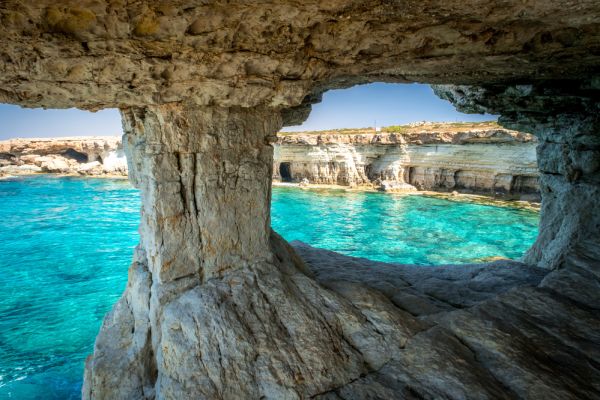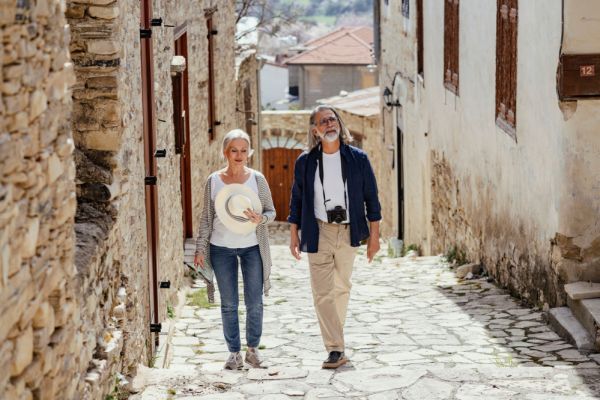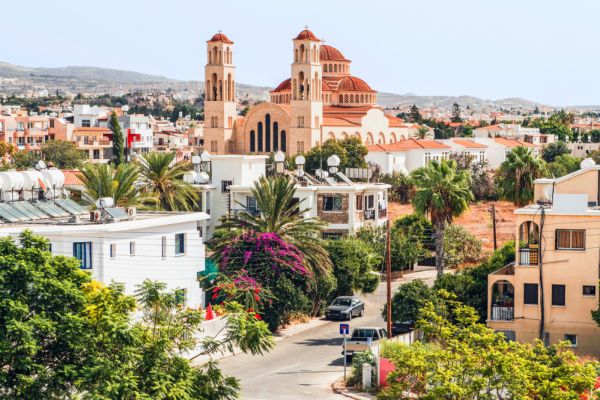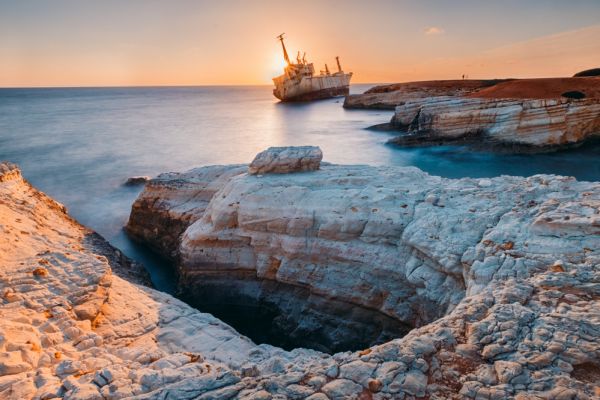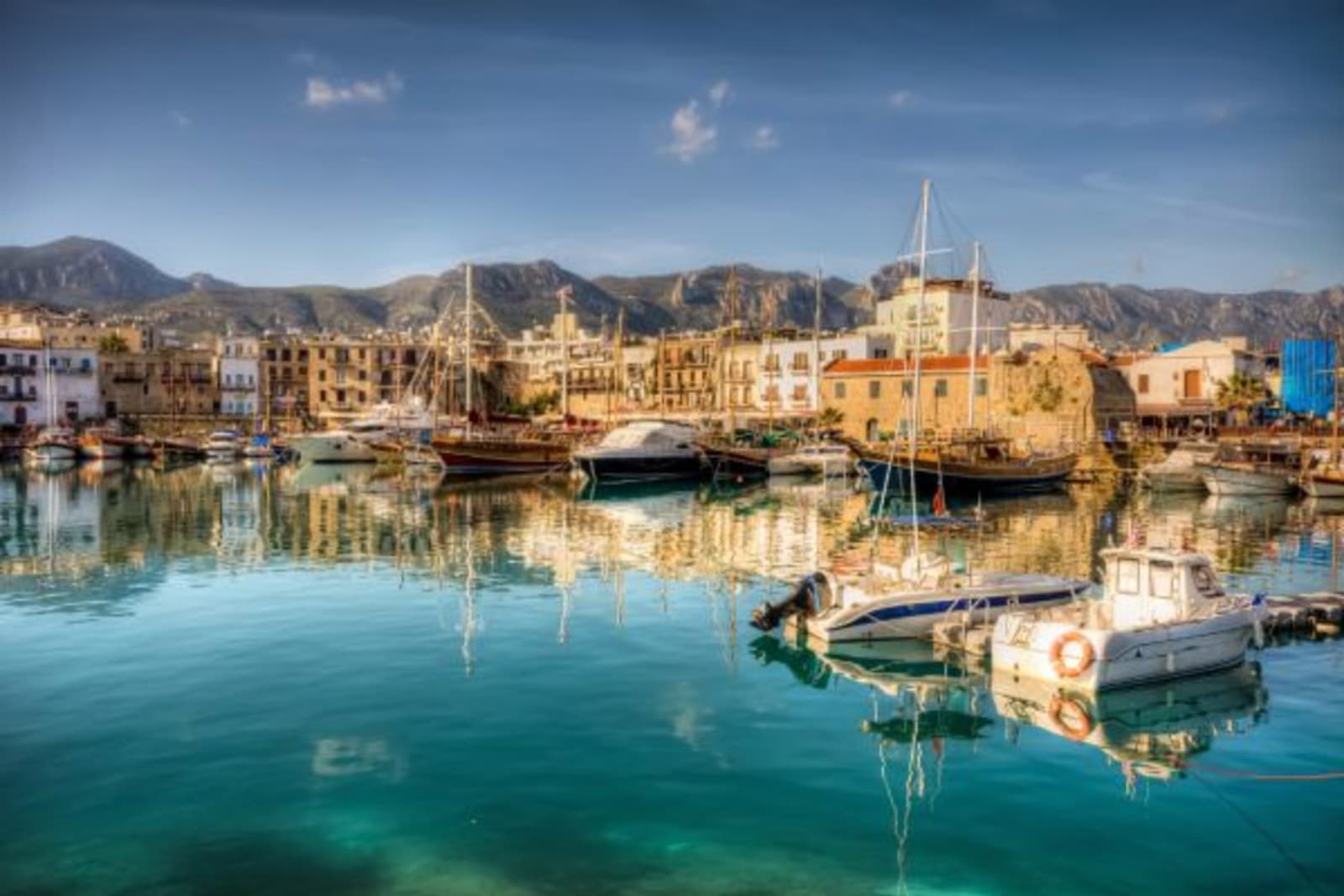CyprusTravel Guide
Cyprus, the third largest island in the Mediterranean Sea, is famous for its many Blue Flag beaches, quaint villages, fascinating ancient ruins and sunshine all year round. Surrounded by three continents – Europe, Asia and Africa – it’s also known as the “Love Island” or “Island of Aphrodite”. According to Greek mythology, the Goddess of Love was born on Cyprus’s Aphrodite’s Rock. No wonder it’s a top destination for loved-up couples, engagements, weddings and anniversaries!
Beach and nature lovers are also drawn to Cyprus because of its diverse coastline of golden sands, rocky shores and secluded coves, and inland, the island is dotted with citrus groves and mountains with many scenic hiking trails and waterfalls to discover.
The island's rich historical sites, including Byzantine buildings and Roman ruins, appeal to history enthusiasts, while the party crowd heads to the nightclubs and beach parties in the resort town of Ayia Napa.
Cyprus’s cultural influences include Greek, Turkish, British colonial and Byzantine, adding to its intrigue.
Find out more reasons to visit in our Cyprus Travel Guide!
Explore Cyprus
Where to stay in Cyprus?
Before we dive in, a quick but necessary political lesson. Did you know? Cyprus is a divided island with a divided capital city – Nicosia. A United Nations buffer zone (the Green Line) separates the two sides of Cyprus where the north is home to Turkish Cypriots and the south to Greek Cypriots. Their relationship status? “It’s complicated”.
The south is more geared towards tourists with good infrastructure and accommodation near attractions. The north has a less developed tourism infrastructure but offers a truly authentic experience.
For a luxury family-friendly stay, the Coral Beach Hotel & Resort is ideal, set on the golden sand of Coral Beach near Paphos. A kids' club, crèche, playground, and waterslides will keep your children occupied while you relax at the spa or indulge your creative side with an arts and crafts class.
A retreat more your style? The Troodos mountains form a region that covers about half of Cyprus, where old monasteries and stone houses have been beautifully restored and transformed into guesthouses, boutique hotels and serene spa retreats. Traditional houses in the village of Kalopanayiotis are part of Casale Panayiotis, a luxury spa retreat that takes advantage of the mountain views and peaceful village life.
In the Lofou village of Limassol, you can stay in a stone building dating back to 1794. With arches, chandeliers and fireplaces, the self-catering units at Agrovino Lofou are perfect for a romantic holiday.
The gorgeous harbour city of Kyrenia is the tourism centre of the north. The Kyrenia Harbour Apartments with their quaint exteriors of stone walls and wooden balconies, are modern inside. Providing exceptional views over the water and all the amenities you need to self-cater, including a full kitchen, this is an ideal base to explore the area.
Keen on a five-star stay? The Grand Pasha Hotel, also in Kyrenia, is as grand as its name and houses a casino and spa.
Over in Famagusta, in the heart of the Old Town, Malia Holiday Let offers a central, affordable stay in spacious self-catering apartments. Enjoy the views from your private balcony, the free Wi-Fi and explore the city on foot.
Believe us when we say, this is just the start. Book your accommodation today!
Things to do in Cyprus
Day trips to the other side from where you're staying give you a chance to experience both cultures and the island's many attractions, including natural beauty, outdoor activities, history and culture. Crossing from one to the other is easy; you just need your passport! There are several designated checkpoints to cross as a pedestrian or in a vehicle. Here are our picks from both sides:
If you’re fascinated by stories of the Berlin Wall or you’ve been to Ireland, you’ll be intrigued (and somewhat saddened) when you walk along the Green Line and see abandoned buildings, deserted streets and protest graffiti. Some parts are still inhabited. We recommend taking a guided tour for context and insights. You can also visit parts of the Varosha ghost town about 4km from the centre of Famagusta, which was called the "French Riviera of Cyprus" in its heyday.
Take a boat ride from Protaras on the south-eastern side of Cyprus to Cape Greco and feast your eyes on the gorgeous coastline, turquoise waters and towering cliffs honeycombed with secret coves. Swim in sea caves, do a 10m dive off the rocks into the ocean, and float in the remote Blue Lagoon.
Cyprus also has a modern, edgier side, reflected in its street art. Most main cities have permanent works to discover on a walkabout, while the Old Town of the divided capital Nicosia is a hotspot! Join a street art tour to find some of the best pieces, or coordinate your holiday with the annual Street Life Festival in Limassol in April, when artists turn the streets into canvases.
Cyprus has more than 60 Byzantine sites, including monasteries and churches. If this spectacular architecture featuring frescoes and icons fascinates you, head off on the Byzantine church route that travels through three regions in the Troodos Mountains in Southern Cyprus. In the Solea region, the 11th-century Kykkos Monastery is one of the most popular tourist attractions, perched on a mountain peak. It’s one of the most ornate, with gold interiors, arches, mosaics and frescoes that tell stories of saints and angels. It houses an equally ornate museum.
A must-visit Byzantine castle in Northern Cyprus is the Saint Hilarion Castle in the Kyrenia Mountains, with its specular views of the Mediterranean. Steeped in folklore and legend, the well-preserved remnants of this fairytale castle are an architectural wonder.
The coastal city of Kyrenia in the north dates as far back as the 10th century BC. Its harbour – a colourful scene of fishing boats, wooden balconies and cafés – is guarded by the imposing Kyrenia Castle. Spend an afternoon exploring the castle and the Shipwreck Museum next door, which houses the oldest shipwreck taken from Cypriot waters – a 4th-century Greek merchant ship.
Many other shipwrecks haunt the waters around Cyprus. The Zenobia shipwreck off the coast of Larnaca in the south is rated among the best scuba dive wrecks in the Mediterranean.
For fascinating on-land ruins in Northern Cyprus, head to the ancient Greek city of Soli and the Salamis ruins. In Southern Cyprus, we recommend the Tomb of Kings and the spectacular Roman mosaics in Paphos (read more in the parks section). You’ll see what’s left of cities, dramatic amphitheatres, tombs, Turkish baths, mesmerising mosaics, colonnades and ghostly caves.
You could say that Aiya Napa is to Cyprus what Ibiza is to Spain. The picturesque resort town is an up-and-coming international party destination with many clubs, bars, and beach bashes that attract the younger crowds looking for affordable entertainment. Once the sun sets, shake off the ancient dust and shake your booty instead – or even join the sirtaki – it’s all here in Aiya Napa!
Looking for an immersive experience? Then a tour is the way to go.
Flights to Cyprus
Cyprus food and drink
Cypriot cuisine reflects Greek and Turkish influences, from mezze platters to grilled seafood, paired with a glass of delicious local wine. Carb-lovers will be in for a treat as Turkish Cypriot food features a lot of bread and pastry, like the cheese-filled pilavuna!
Luxury hotels have become synonymous with fine dining experiences and Nammos – the upmarket restaurant at Parklane Resort in Limassol in the south – promises to wow your taste buds! The menu features caviar, seafood and beef cuts, paired with the flavours of the Mediterranean.
Enjoy a Mediterranean feast at Viklari, The Last Castle restaurant near Paphos in Southern Cyprus. Stone slab tables and wooden chairs are set under a canopy of grapevines on the terrace overlooking the Akamas Peninsula. Enjoy carafes of wine, mezze and souvla – meat on a giant skewer slow-cooked over a barbecue.
For authentic Turkish Cypriot dishes, the Kemeraltı Aşevi Restaurant in Büyükkonuk on the Karpaz Peninsula in Northern Cyprus is a great choice. This low-key eatery serves deliciously simple, traditional village food like lamb kleftiko (lamb roast) and chicken kebabs.
The Cyprus Farmers Market in Yeroskipou, a coastal village near Paphos in South Cyprus, sells organic fresh produce, olives and traditional Cypriot products like halloumi and lokum (Turkish delight). It's one of the island's specialities, and this squidgy, icing-sugar-dusted confectionary features many unique flavours like pistachio, cinnamon or orange.
In North Cyprus, the village of Büyükkonuk is known for its weekly cooperative market and annual Eco Day festival showcasing local delicacies.
Other than markets, street food is also sold by beach vendors and at beachside kiosks. Must-tries in the south include spanakopita (pastry filled with spinach and feta), kolokythokeftedes (zucchini balls) and loukoumades (mini deep-fried doughnuts drizzled with honey). In the north, a similar sweet treat is lokma (deep-fried pastry balls soaked in honey or syrup), then there’s the popular simit (a chewy, slightly sweet round bread topped with sesame seeds), hellimli cheese (known as halloumi in Greek), and if you’re really hungry, kebabs or dürüm (a wrap with doner meat, salad, and sauce).
Get a real taste for the local cuisine by booking a tour.
Cyprus through your eyes
Where to shop in Cyprus?
From shopping malls and boutiques with international brands to traditional markets and bazaars, there are plenty of shopping experiences to be had.
In the centre of the capital, Nicosia, the best place to shop is along the pedestrian-only Ledra and Onasagorou streets, which run parallel and are lined with all kinds of modern and traditional stores. These streets lead further into the buzzing Old Town with its cafés and eateries. Groovy the Store, a concept gift shop on Onasagorou Street is a must-visit.
My Mall in Limassol is a shopping, dining and entertainment hub where you can find top fashion brands like Zara, Guess and Aldo. There are also outlets selling jewellery, gadgets, gifts and toys, and a unique feature is an ice rink! Still in Limassol, the yacht-lined Marina offers a selection of boutique shops and convenience stores.
For an authentic shopping experience, head to Paphos and the unique destination called Hani of Ibrahim – a collection of artist studios and workshops that sell beautiful local silks, porcelain, art, jewellery, musical instruments and even deli delights like Cypriot cheese and carob syrup.
Larnaca boasts the shiny Metropolis Mall but also different kinds of shopping experiences. The Finikoudes Promenade, lined with palm trees and sea views, features shops selling souvenirs and beachwear, as well as various markets selling vintage goods and local handicrafts.
Northern Cyprus is a tax-free zone, so you can enjoy shopping more for less! Famagusta boasts the high-end City Mall with all the typical international brands and a food court, while Girne Park AVM is Kyrenia’s biggest mall housing more than 70 shops, and a cinema.
If you enjoy open-air shopping, the Arasta Bazaar in north Nicosia is a shopping street with a vibey atmosphere, selling a wide selection of items from clothing and accessories like scarves and bags to souvenirs. Haggling for a good price is customary, so don’t be shy!
Over in Kyrenia, you can shop for gifts at the Kyrenia Castle like evil eye trinkets and souvenirs, but if your passion is for antiques and collectibles, Karakum Village, on the outskirts of Kyrenia, is worth a visit. It takes under 15 minutes to get there by car.
Looking for a safe and simple way to bring your money when you travel? Our Travel Money Card has you covered!
When is the best time to travel to Cyprus?
Cyprus has a Mediterranean climate on its coast with hot, sunny and dry summers and mild winters. It’s also the hottest island in the Mediterranean! Sun lovers flock to the beautiful beaches in summer from June to August, which is also peak season. Inland the temperatures can be as high as 40°C (104°F) during these months, with no rain, while the coastal areas are cooled by sea breezes.
Low season is in the rainy winter from mid-November to February, but the sun still shines on days with no rain. Daytime temperatures are around 15°C (59.8°F) on the coast so it’s a great time to visit Cyprus if you enjoy cooler temperatures and less expensive end-of-year holidays without the crowds. Up in the mountains, winter brings a dusting of snow to the peaks of Mount Olympus and temperatures are around 5°C to 10°C (41°F to 50°F) during the day. At night they sometimes drop to 0°C (32°F).
The short shoulder seasons of spring and autumn are the best time to visit Cyprus when temperatures are mild, although the weather can change suddenly. Spring is from April to May, and autumn is from September to October with an average daily temperature of around 25°C (77°F), but once again, it differs by location.
Don't miss out. Book your flight today!
How to get around Cyprus
Public transport in Cyprus is mainly bus-based, but transport options differ in the north and south. While the south has a more organised and extensive network, transport in the north is run by private operators and shared taxis.
Bus services run throughout the south with InterCity Buses travelling on routes connecting major towns and major cities and even some rural areas. Urban buses run frequently on routes in the main cities and towns with extended hours during tourist season. But note that public buses can be scarce on weekends, evenings and off-season.
Rural buses service smaller villages in outlying areas and the mountains, connecting them to the nearest towns, but these only run a few times a day.
Bolt rideshare exists on the island, as do metered taxi services (hail them on the street or call and book).
Shared taxis or minibuses are a common and affordable form of transport, operating on fixed routes between towns and cities but not on a strict schedule. Known as a dolmuş locally, they are white vehicles, with the destination displayed in the window. You can board one at designated stops or flag one down.
If you’re crossing from one side to another, be aware that there are no direct bus services across the Green Line. You’ll need to walk across and catch another bus on the other side.
Taxis are common at taxi ranks and hotels, but some drivers don’t use meters, so discuss the fare before you get in.
By far the best way of getting around and exploring is to rent a car. Car parks exist at all the main attractions and centres.
Let us help you organise your own wheels for exploring. Hire a car today.
What are the best beaches in Cyprus?
Cyprus has many stunning beaches to choose from – and more than 50 Blue Flag beaches! In the south, top beaches are clustered around the major towns of Paphos, Limassol, Larnaca, and Ayia Napa. In the north, the beaches on the Karpaz Peninsula offer a wild beauty and are home to sea turtles who nest on their shores.
Fig Tree Bay is a gorgeous Blue Flag beach in the tourist resort of Protaras. Fun fact: It’s named after a lone fig tree that’s been growing there since the 17th century! Stroll along the golden sand dotted with sun loungers, swim in the shallow waters or enjoy the many water sports like jet skiing and parasailing, then head off for a meal at a nearby restaurant.
Konnos Bay in the Cape Greco National Forest Park, close to Ayia Napa, is another Blue Flag beach. It’s a small, tranquil, horseshoe-shaped beach with white sands and lined with pine trees. The shallow, calm waters make it popular with families and it’s less touristy than some other beaches.
Mackenzie Beach near to the Larnaca International Airport is also a Blue Flag beach popular with locals and tourists because of its lively atmosphere, the promenade lined with bars and restaurants and central location.
Golden Beach is a picturesque gem at the tip of the Karpaz Peninsula. The long stretch of beach is surrounded by golden sand dunes, nature and home to wild donkeys! Read more about them in the parks section. It’s a protected area where loggerhead and green sea turtles nest on the quiet shores in summer. The clear waters are ideal for swimming and snorkelling and are also known for bioluminescent plankton, which create a glow in the water at night when disturbed.
Another top beach and turtle hotspot is the Alagadi Turtle Beach, about 20 minutes from Kyrenia. This serene, beautiful beach of two sandy bays is also a nesting site for sea turtles where you can book a “night-watching tour” to observe their activities. During the day, you can swim or stroll along the beach but note that amenities are limited due to the conservation of the turtles.
What are the best parks in Cyprus?
The island has several national parks and forest parks with incredible biodiversity, where you can also encounter wine producers, villages, ancient history, and waterfalls!
The island’s largest national park is situated in central Cyprus. Lace up those hiking boots and head off on one of the many nature trails to discover not only striking landscapes but also stone villages, Byzantine monasteries, and vineyards. Stop for a wine tasting, enjoy the scenic picnic spots and follow paths leading to cascading waterfalls and refreshing pools, ideal for a post-hike swim.
For family fun, the Adventure Mountain Park in the Troodos Mountains offers paintball, archery, laser tag and Forest Puzzles – an activity a bit like the Amazing Race!
This picturesque woodland park near Nicosia on the south-eastern side is a family favourite. Some of its features include botanical gardens, a playground, nature trails, and a lake with a bird hide. It’s also popular with cyclists.
Take a walk through this park, a UNESCO World Heritage Site, and immerse yourself in the ancient history of the area showcased through mosaics, structures and monuments dating from the 4th century BC to the Middle Ages. View the exquisite Roman mosaic floors in four villas, explore the Paphos Lighthouse, the Saranta Kolones (Forty Columns) Castle and the impressive Tomb of Kings carved into rock underground.
This park in Northern Cyprus on the Karpaz Peninsula offers diverse landscapes, including cliffs and beaches. But it’s even more famous for its wild but friendly donkeys! You can feed and interact with them, making this an ideal place to visit if you’re travelling with kids. Hiking, birdwatching, and relaxing on the beaches are other activities to enjoy here.
Getting from park to park is so much better with your own wheels. Hitch your ride now!

